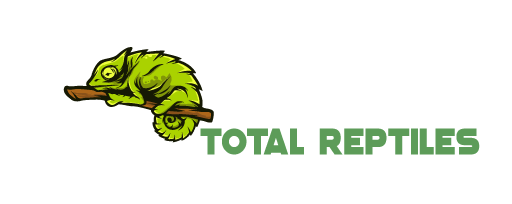Bearded Dragon Shedding is a natural part of a bearded dragon’s life. Their outer layer of skin needs to be replaced regularly as they grow and their cells die off. But even adult dragons shed every so often – it’s like changing clothes for them!
Shedding is a normal behavior for beardies, but as an owner, you can take steps to make it easier on them. With the right habitat setup and a little TLC during shedding cycles, you can help ensure your dragon stays happy and healthy!
While shedding is normal, there are steps you can take as an owner to make the process smooth for your scaly friend. So whether you’re a new dragon parent or a seasoned veteran, you will learn something new today.
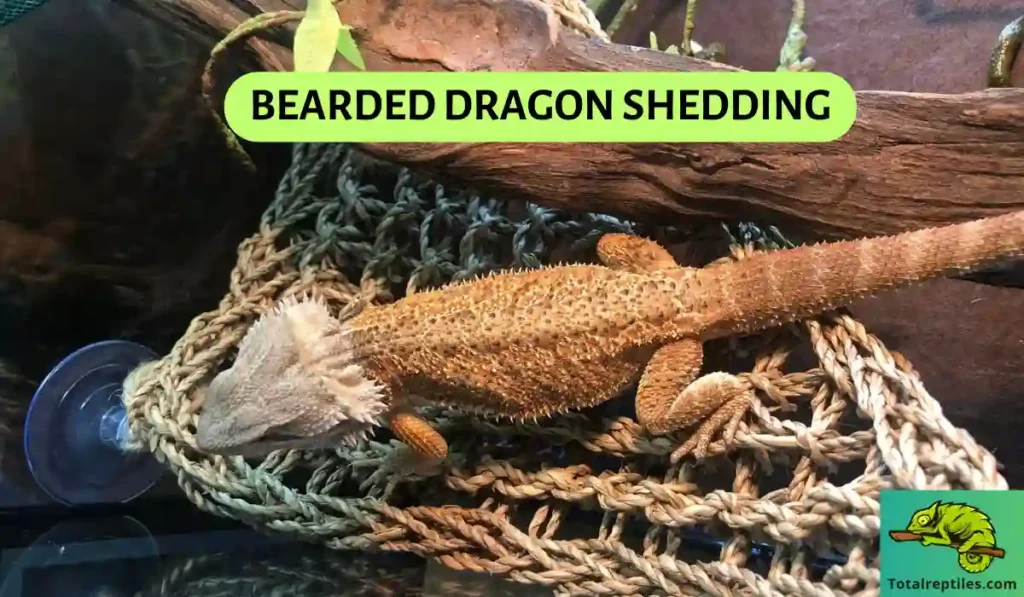
Why Do Bearded Dragons Shed Their Skin?
Shedding allows bearded dragons to grow a new outer layer of skin literally. But it’s not just for growth – their skin must be replaced regularly as cells die off.
Take a closer look at bearded dragon skin and the reasons these lizards shed:
Their Skin Can’t Stretch
A bearded dragon’s skin comprises tough keratin scales that form a protective barrier. But this skin isn’t very elastic – it can’t stretch and grow with the lizard.
Babies and juveniles, in particular, are growing rapidly, easily outgrowing their skin in a matter of weeks! Adults slow down but still need to shed periodically.
Unlike snakes that shed their skin in one piece, bearded dragons shed in patches. New skin grows underneath before the old layer peels off in flakes.
Shedding Due to Growth
For young, growing bearded dragons, shedding happens frequently as they outgrow their skin. Without shedding, their bodies would be squeezed uncomfortably!
- Babies may shed every week as they rapidly gain length and mass.
- Juveniles shed a bit less often as growth slows but still need to replace their skin routinely.
Shedding happens less based on growth needs once adulthood is reached and growth levels off.
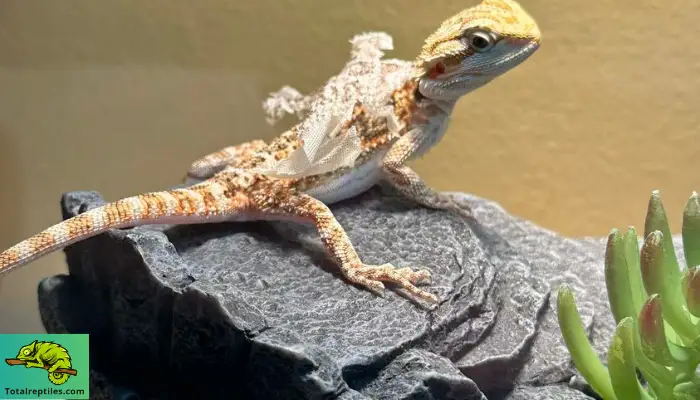
Shedding Due to wear and tear
Even adult bearded dragons need to routinely replace their skin as the outer layer gets worn down or damaged:
- Their tough scales get scratched and dulled through rubbing against rocks and logs.
- Skin parasites like mites can burrow under scales.
- Their outer skin layer gets old and dies off after a while.
So, shedding allows adult bearded dragons to refresh their skin every few months.
Other Benefits of Shedding
Along with enabling growth and replacing worn-out skin, shedding has other benefits for a bearded dragon’s health:
- It allows more efficient absorption of UVB rays to produce vitamin D3 with fresh skin.
- Shedding removes external parasites like mites along with the skin they inhabit.
- Eating the shed skin allows beardies to recoup nutrients like calcium that are locked into the skin.
Bearded dragons shed to grow, refresh their skin, absorb more UVB, remove parasites, and reabsorb nutrients! It’s a critical process for their health.
How Often Do Bearded Dragons Shed?
The shedding frequency depends greatly on a dragon’s age and growth rate.
How Often Do Baby Bearded Dragons Shed?
Shedding happens frequently for baby dragons under 6 months old as they rapidly increase in size. It’s common to see a full skin shed as often as every 1-2 weeks!
Their bodies are expanding quickly, so their skin just can’t keep up. Frequent shedding allows their covering to accommodate fast juvenile growth better.
Juvenile Bearded Dragons
Juvenile dragons from 6 to 18 months old have slowed down but are still actively growing. Their shedding frequency decreases accordingly:
- 6-12 month-olds shed about every 4-6 weeks.
- 12-18 month-olds shed every 2-3 months.
Their growth rates determine how often the skin needs to be replaced as they outgrow it. Expect shedding around once a month to once every other month.
Adult Bearded Dragons
Once adulthood is reached after 18 months, bearded dragons are fully grown. Shedding happens only 2-3 times per year on average for adults.
Their shedding cycle is no longer tied to growth but based on skin replacement needs as cells reach the end of their lifespan and scales get scratched or damaged.
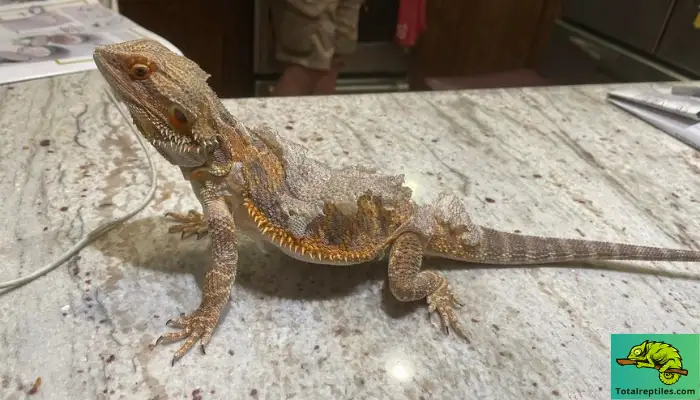
Individual Variation
While these averages provide a general guideline, the shedding frequency can vary a lot for individual dragons based on:
- Genetics
- Growth rates
- Overall health and skin condition
- Environment (temperatures, humidity, etc.)
So don’t be alarmed if your beardie sheds a bit more or less than expected – every dragon is different! Just watch for very abnormal shedding patterns.
Bearded Dragon Shedding Signs
Recognizing when your bearded dragon is gearing up for a shed will help you prepare. There are a few common signs that a shedding cycle is about to begin:
Dull, Faded Skin
The most obvious visual cue is their skin will lose its vibrant coloration and turn dull and grayish. You may see flaky or peeling sections as the outer skin separates from new layers forming underneath.
Lethargy
Many beardies become more lethargic and inactive around shedding time. This is normal as they conserve energy during this taxing process. They may spend more time sleeping than usual.
Irritability
Shedding can cause irritation and discomfort. Your normally docile dragon may get grumpy and not want to be handled. They also may scratch more against objects.
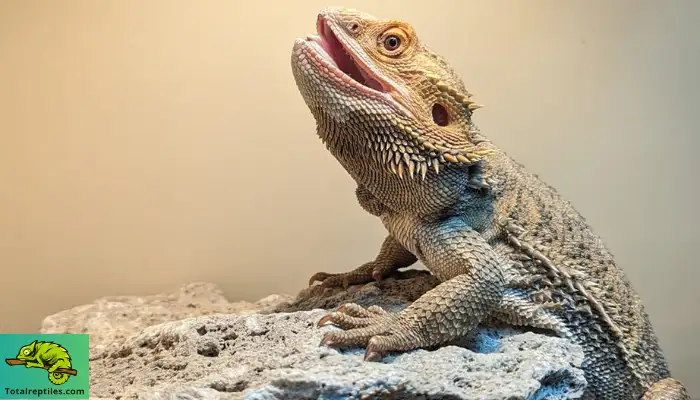
Loss of Appetite
Appetite loss often accompanies shedding since beardies are feeling under the weather. Don’t worry if your dragon refuses food for a few days around shedding time.
Eye Appearance
You may notice your dragon’s eyes take on a hazy, bluish-gray tone and appear swollen. They “pop” their eyes slightly to help loosen the skin around this sensitive area.
Black Beard
Some dragons will display a black beard as part of their mood shift before shedding. This signals they are feeling stressed or irritable.
Keep an eye out for these common pre-shed indicators. Once you see them, you can take steps to get your beardie shed-ready!
Bearded Dragon Shedding Process
Let’s walk through the full shedding process from start to finish. Here’s what you can expect when your bearded dragon begins to shed:
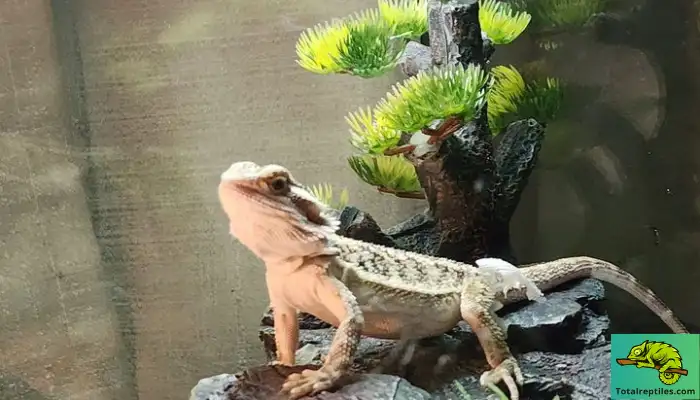
Timeline
A full shedding cycle takes 1-3 weeks on average to complete. The timeline depends on the dragon’s age:
- For babies, shedding happens rapidly and may only take a couple of days.
- Juveniles shed a bit slower over 1-2 weeks.
- Adults take the longest time at 2-3 weeks for a full shed.
Getting Ready
Leading up to the full shed, you’ll notice your dragon’s pre-shed behaviors like lethargy and dull skin. Underneath the outer skin, a new layer is forming to replace it.
Enzymes begin dissolving the connections between the old and new skin layers to allow separation.
Rubbing and Scratching
Once the shedding process begins, your bearded dragon will engage in lots of rubbing and scratching against any rough surface in their habitat.
This helps loosen and slough off the old outer skin. You’ll see large flaky patches coming off their body rather than the skin peeling off in one piece.
Eating the Shed Skin
It’s normal for beardies to eat their shed skin once it comes off! This allows them to reabsorb beneficial nutrients like calcium locked into the skin.
In the wild, eating the skin also removes traces of the dragon’s presence after shedding. But for pet dragons, it’s primarily nutritional.
Shedding the Tail
The process takes longer for a bearded dragon’s tail than the body. You may notice tail shedding a week or two after** the body.
This is normal! Just keep an eye on the tail tip prone to retained shed.
Sensitive Areas
Other spots like the face, eyes, legs, and toes are also sensitive. Your dragon may pay special attention to rubbing these regions against surfaces to remove the shed.
Finishing Up
Once the full shedding process concludes after a couple of weeks, your dragon’s colors will be vibrant again! Enjoy their fresh, shiny new skin.
Make sure to inspect for any retained or stuck shed and address it promptly. Besides that, your shedding pro should be good to go.
Helping Your Bearded Dragon Through a Shed
While bearded dragons shed their skin naturally, there are some things you can do as an owner to make the process easier on them:
Set Up Their Habitat Properly
The most important step is providing your beardie with an optimal habitat. Having proper lighting, temperatures, humidity, and furnishings makes shedding smooth.
Specifically, ensure they have a rough basking surface and logs/branches to rub against to help slough off skin.
Give Them a Warm Bath
A warm bath once or twice a week while shedding can aid the process. Make sure the water only comes up to about the middle to keep it comfortable.
Moisture softens skin and makes removal simpler. Gently rubbing with a soft toothbrush can help loosen clingy areas like the toes after a soak.
Increase Mistings
Misting their habitat 1-2 times a day lightly raises humidity levels. Adding moisture can help hydrate dry, flaky skin, allowing it to separate and shed.
Aim for their body and any visibly peeling areas when misting to target the shedding skin directly.
Provide Shedding Aids
Special shedding aid products can help when baths and misting aren’t enough. These sprays contain oils that deeply moisturize the skin.
Apply as directed if your beardie still has difficulty shedding after trying other remedies. It gives their skin an extra boost.
Give Them Space
One of the best things you can do is give your beardie space and privacy while they are shedding. Handling and other direct contact will stress them out.
Respect their signals like a black beard and let them rest until the shed ends. Limit contact and keep handling to a minimum during this time.
Watch for Problems
While most sheds go smoothly, improperly shedding is possible. Stuck shed on the tail, toes, or face is most concerning.
Monitor for any stuck skin constricting blood flow – characterized by discoloration. If issues persist, a vet visit may be needed.
Can You Hold a Bearded Dragon While Shedding?
It’s best to avoid handling or holding a bearded dragon while they are shedding. Shedding is an uncomfortable process for them, so contact adds unnecessary stress.
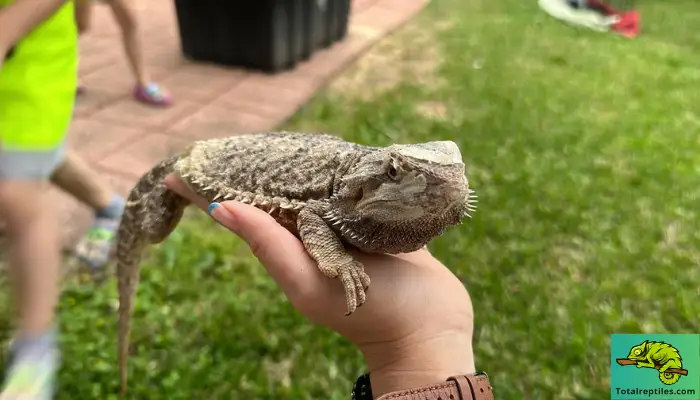
Signs your beardie doesn’t want to be held during a shed include:
- Hiding more than usual
- Turning black when approached
- Gaping mouth or puffing up
- Twitching or fidgeting while held
Excessive handling can also disrupt their shedding by removing skin before it’s ready. And new sensitive skin underneath may get damaged.
Give your bearded dragon privacy and space while they shed. Limit contact to quick spot checks and any baths or misting that help the process.
Once their colors perk up again, signaling the shed is complete, you can resume normal handling routines. But it’s kindest to let them be while skin is sloughing off.
Can You Bathe A Bearded Dragon When Shedding?
Bathing during a shed is not only safe for bearded dragons; it can help the process along! The moisture aids in loosening and removing dull, flaky skin.
Fill a tub with lukewarm water. Place beardie in the bath and soak for 10-15 minutes. The water should come up to about the middle of their body. Avoid getting water on their head.
You can gently massage shedding areas like the limbs and tail with a soft brush or your fingers to help loosen the skin. But never forcefully pull off any pieces!
After the bath, pat your dragon dry with a towel. Repeat the bath 1-2 times weekly during a full shed cycle. It rehydrates the skin, allowing for easier shedding.
Why Is My Bearded Dragon Not Shedding?
As a bearded dragon owner, you likely know that shedding is a normal and healthy process for these reptiles. So it can be concerning if your beardie isn’t shedding at all.
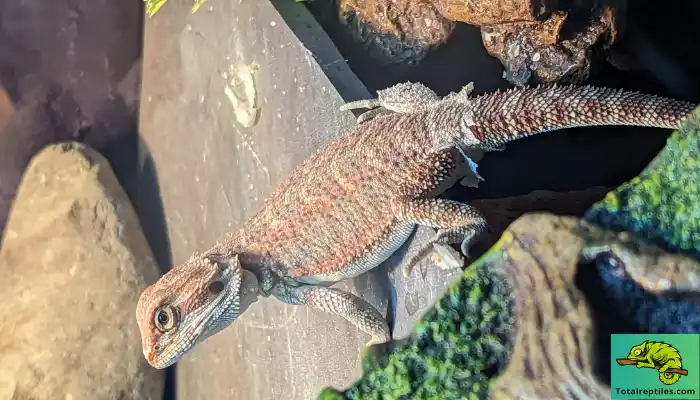
There are a few potential reasons why your bearded dragon may not be shedding properly:
Improper Habitat Conditions
One of the most common reasons for the lack of shedding is incorrect habitat conditions. Bearded dragons need specific temperatures, lighting, humidity levels, and tank furnishings to shed successfully:
- Temperatures that are too low prevent proper skin growth and shedding ability. Ensure the warm side is 95-110 F.
- Insufficient UVB rays inhibit skin development. Use a quality UVB bulb and replace it as recommended.
- Low humidity makes skin dry and difficult to shed. Mist the tank regularly to boost humidity.
- No rough surfaces for rubbing/grinding means the skin can’t detach. Add rocks, logs, etc.
Dehydration
Hydration is crucial for easy shedding. Dehydrated skin is thicker and dry. Ensure your beardie has a water dish they can soak in, and mist the tank to increase hydration.
Poor Diet & Nutrition
Nutrient deficiencies can greatly impact skin health. your bearded dragon’s feeders are gut-loaded and dusted with calcium + multivitamin supplements.
Underlying Health Issue
Medical problems like infection, parasites, metabolic bone disease, etc. may prevent shedding. Have your beardie examined by an experienced reptile vet.
Too Young or Too Old
Bearded dragons under 3 months or over 5 years old shed very infrequently. Lack of shedding may be normal at these ages. Monitor other signs of health.
With attention to hydration, habitat, nutrition, and health, your beardie should begin shedding regularly again. If problems persist, a vet visit is recommended to diagnose and address the cause.
Consequences of Incomplete Shedding
Partial sheds are most concerning when skin remains stuck on digits, tails, and other extremities.
The retained shed constricts blood flow to these areas as it shrinks and dries out. This can lead to:
- Loss of toes or even entire feet
- Necrosis and infection
- Tail necrosis and even dropping
So improper shedding can become serious if untreated.
What to Do
If you notice signs of Dysecdysis like retained shed on extremities or other areas, take action:
- Address any husbandry issues like heating and hydration
- Provide a hydrating bath and gently remove stuck skin with a soft brush
- Use a commercial shedding aid if needed
- See a vet promptly if problems persist – don’t wait!
While issues are uncommon in healthy dragons, it’s important to monitor for shedding problems, which can have severe consequences.
Do Bearded Dragons Eat Less When Shedding?
It’s very common for bearded dragons to experience a decreased appetite and eat less when going through a shed. This is normal seasonal behavior for them.
Shedding takes a lot of energy, so beardies tend to feel more lethargic and uninterested in food. Eating their shed skin also provides nutrients, so they don’t need as much from other sources.
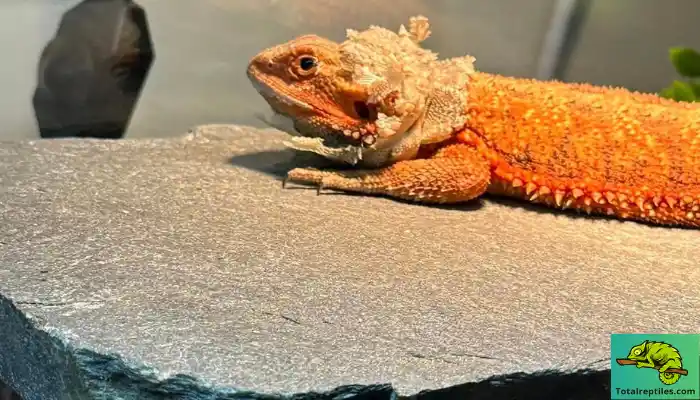
Don’t panic if your dragon skips meals or eats less for a few days before and during shedding. Offer their normal diet, but don’t force food if they refuse it. The appetite should bounce back once the shed is complete.
Significant appetite loss lasting more than a week or complete disinterest in food could indicate an underlying health issue. In these cases, schedule a vet visit to address the problem.
FAQ
Why is my bearded dragon not shedding?
Lack of shedding usually stems from improper husbandry. Make sure temperature, UVB, hydration, nutrition, and habitat furnishings are all ideal. Medical issues can also prevent proper shedding. See a vet if problems persist.
Why Does My Bearded Dragon Shed So Much?
Frequent shedding beyond normal for their age is likely tied to issues like dehydration, parasites, illness, or stress. Have your dragon examined by a qualified reptile vet.
My bearded dragon has stuck shed – what should I do?
Try a warm bath and gentle brushing with a soft toothbrush first. Apply a commercial shedding aid if needed. Monitor for signs of restricted blood flow. Seek vet care promptly if the stuck shed doesn’t resolve or causes discoloration.
Conclusion
Now you know everything about the natural shedding process for bearded dragons! Shedding allows them to grow and replace their skin. It happens more often when they’re young and less as adults.
While beardies shed on their own, you can help by providing a proper habitat, baths, gentle brushing, and space. Watch for signs of difficulty shedding, which may require a vet visit.
You can keep your bearded dragon comfortable and healthy with the right care when shedding. They’ll be able to slough off that dull skin and emerge shining and vibrant!
